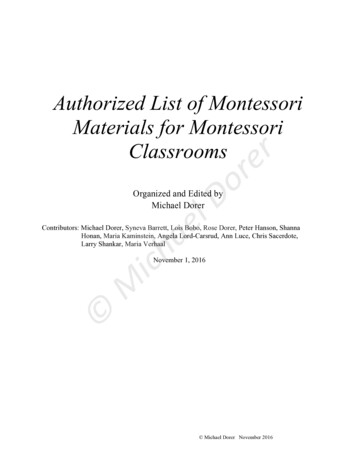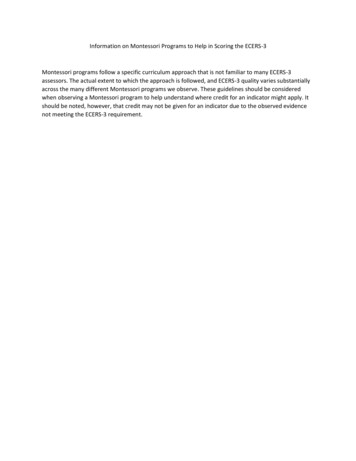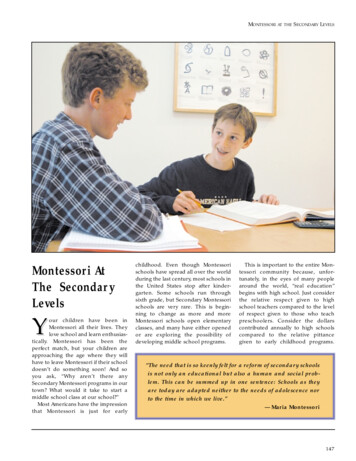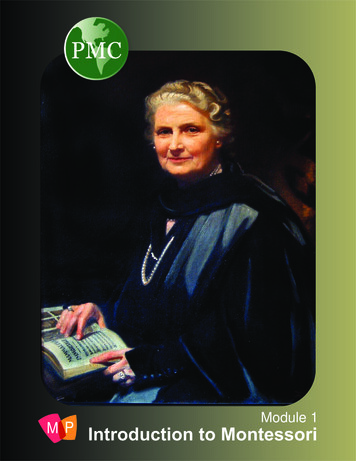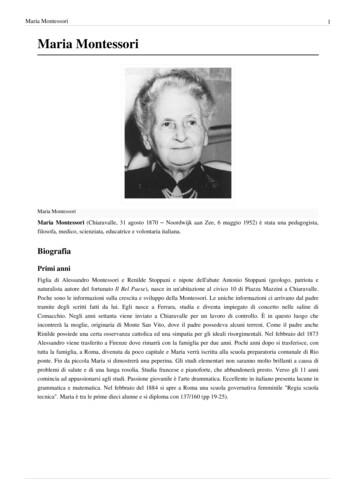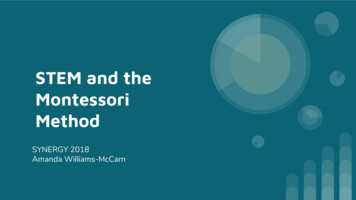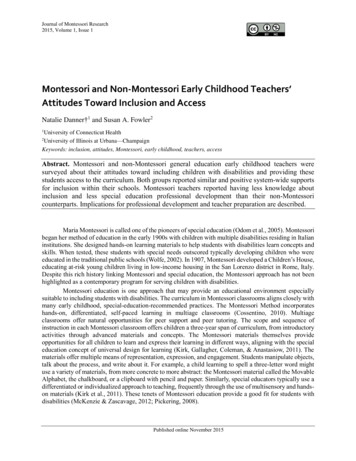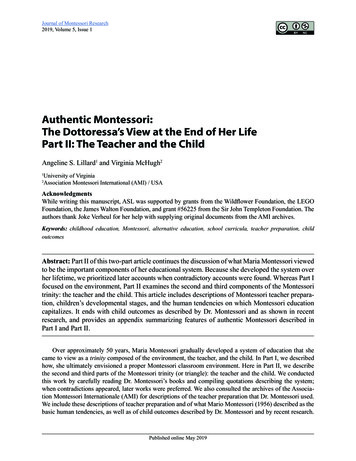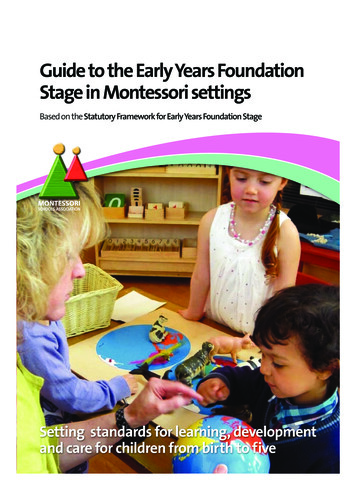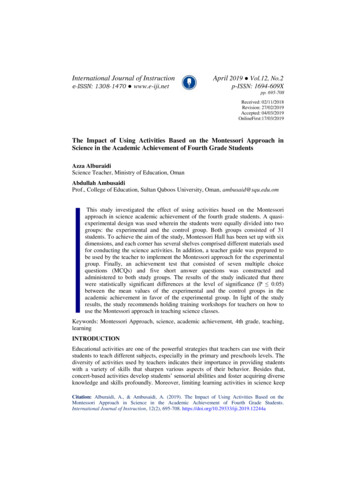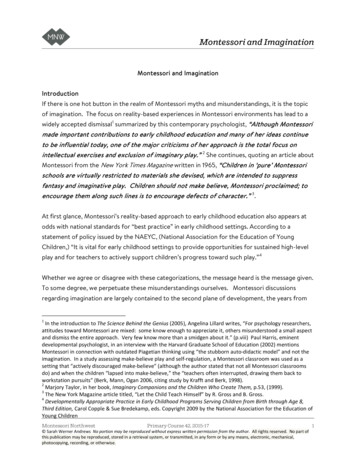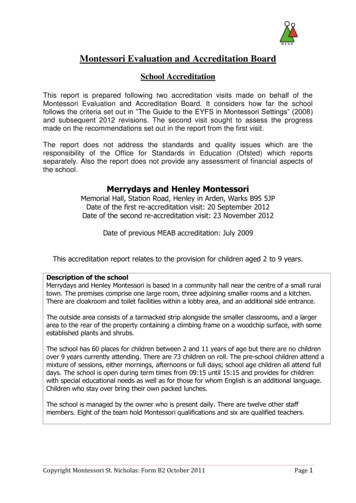
Transcription
Montessori Evaluation and Accreditation BoardSchool AccreditationThis report is prepared following two accreditation visits made on behalf of theMontessori Evaluation and Accreditation Board. It considers how far the schoolfollows the criteria set out in “The Guide to the EYFS in Montessori Settings” (2008)and subsequent 2012 revisions. The second visit sought to assess the progressmade on the recommendations set out in the report from the first visit.The report does not address the standards and quality issues which are theresponsibility of the Office for Standards in Education (Ofsted) which reportsseparately. Also the report does not provide any assessment of financial aspects ofthe school.Merrydays and Henley MontessoriMemorial Hall, Station Road, Henley in Arden, Warks B95 5JPDate of the first re-accreditation visit: 20 September 2012Date of the second re-accreditation visit: 23 November 2012Date of previous MEAB accreditation: July 2009This accreditation report relates to the provision for children aged 2 to 9 years.Description of the schoolMerrydays and Henley Montessori is based in a community hall near the centre of a small ruraltown. The premises comprise one large room, three adjoining smaller rooms and a kitchen.There are cloakroom and toilet facilities within a lobby area, and an additional side entrance.The outside area consists of a tarmacked strip alongside the smaller classrooms, and a largerarea to the rear of the property containing a climbing frame on a woodchip surface, with someestablished plants and shrubs.The school has 60 places for children between 2 and 11 years of age but there are no childrenover 9 years currently attending. There are 73 children on roll. The pre-school children attend amixture of sessions, either mornings, afternoons or full days; school age children all attend fulldays. The school is open during term times from 09:15 until 15:15 and provides for childrenwith special educational needs as well as for those for whom English is an additional language.Children who stay over bring their own packed lunches.The school is managed by the owner who is present daily. There are twelve other staffmembers. Eight of the team hold Montessori qualifications and six are qualified teachers.Copyright Montessori St. Nicholas: Form B2 October 2011Page 1
Summary and conclusionThe philosophy and educational principles of Merrydays and Henley Montessori mirror thoseof Maria Montessori. The reflective practice, led by the owner/manager, ensures that thesetting is adapting and meeting the needs of the children on a daily basis. Following arecommendation made during the first re-accreditation visit, staff have introduced free flowaccess to the outdoor area during the whole of the morning session, which has greatlyimproved the setting’s capacity to give children the opportunity for developing theirdecision-making and self-discipline. Adults work very well together as a single team andtreat all children respectfully, consistently and as individuals. Independence is exhibited byall children from the youngest age. Staff are flexible in supporting the freedom of movementand choice that the children enjoy. Some opportunities for the nursery aged children to leadgroup activities would benefit those children who are confident in their independence.Learning and development is well organized and is based securely in Montessori pedagogy.The orderly and spacious rooms are well planned and used effectively. The wide range ofappealing resources is well cared for by both adults and children within the classrooms.Materials are accessible and clearly arranged in relation to areas of learning. Outsideresources are good, easily accessible for the children and organized in such a way as toenable their cycles of activity to take place.Record keeping is good and, in response to a recommendation made during the first reaccreditation visit, staff are making it a more useful tool for assessing progress, as all therecords for each child are now combined into one document. Parental contribution to recordkeeping is also increasing. Parents are very satisfied with the provision their children receive.Under the strong leadership of the manager, the excellent staff team combines to create aneffective Montessori setting. Through both a commitment to good practice, and a strongwillingness to reflect on their own work, they demonstrate a clear capacity for continueddevelopment.The school provides an education which follows the principles of the Montessoriapproach and environment. The school has successfully achieved the points foraction recommended on the first visit, and this merits accreditation by theMontessori Evaluation and Accreditation Board. Consideration should be given tothe following points for further development: To continue the improvements to the combined record of learning that iscompiled for each child, and to developing the progress tracking system. To encourage primary-age children to record their activities.Philosophy:The manager is fully committed to following Montessori principles within the setting, and thisapproach is shared by all staff.Children benefit from being given the freedom to choose where to work on activities and forhow long. These freedoms are coupled with clear boundaries, and a beautifully cared for andprepared environment. Children are active and engaged, and are shown deep respect from allthe adults who work with them. The children lead the learning whilst the adults facilitate andsupport each individual. Good quality conversation and discussions are emphasized strongly,Copyright Montessori St. Nicholas: Form B2 October 2011Page 2
and the school participates in Warwickshire’s ‘Time to Talk’ language enhancement program.Trust is evident across the school. The layout facilitates good freedom of movement betweenthe rooms, and access to the outdoor areas is for the majority of the day, for all children in theschool. Establishing free flow between indoors and outdoors has enriched the Montessori ethosand provision of Merrydays. Children’s cycles of activity are well established and the attentiongiven by the adults to settling children in and establishing etiquette and routines greatlyenhances the social aspects of the whole setting.The principles and philosophy of the setting are periodically reviewed by staff and are madeclear in the prospectus, website and during face-to-face discussions with parents.Learning and Development:The learning and development provision at Merrydays is strongly rooted in Montessoripedagogy, with well-organized and accessible areas of learning.Both the Montessori curriculum and the Early Years Foundation Stage (EYFS) Framework arecombined effectively for the younger children, with the adults skillfully recording the activitiesdone by these children. All staff work well together to ensure that the planning, recording andassessment of learning supports each child’s development. During both re-accreditation visitsthe work cycle ran from 9.15 to 12.00 for the younger children. The learning during the workcycle was accessed by all children, who displayed high levels of engagement. Children exercisedfree and spontaneous choice when selecting materials, although there were no group activitiesled by them.Whilst outside, the children have free choice of a rich assortment of activities and materials. Theimprovements made to the planning and assessments in this area since the first re-accreditationvisit have enabled staff to increase the number of focused presentations.During both visits the children in the primary room worked well and understood their tasks.They worked from a weekly plan, managing the order of their activities and the time spent onthem. Children spontaneously helped each other with their work and displayed both a sense ofpurpose and joy whilst in the classroom. They would further benefit from increased independentuse of cameras and other equipment to make records of their own work.Record keeping is good, and now that all records are being combined into one document thatalso includes parental contribution, they have been greatly enhanced for the purpose ofassessment of learning and development. The continued use of tracking software will enablestaff to identify individual strengths and weaknesses, as well as areas to develop in theircurriculum.During the visits the adults understood and implemented their roles well, and were able toundertake a diverse range of responsibilities across the day.Prepared Environment: resources and materialsThe setting has four rooms and a reasonably sized outdoor space. The largest room, usedmainly for the youngest children and as a base for art work, is both bright and spacious. TheCopyright Montessori St. Nicholas: Form B2 October 2011Page 3
two smaller nursery rooms have a mixture of tables and floor space with open shelving aroundthe sides of the room. The rooms are organized into areas of learning, with the shelvesarranged in a clear order.Within the nursery rooms there is a good range of practical life, creative, language, sensorial,cultural and early maths materials. All the materials are well cared for by both children andadults, and are accessible and inviting for the children. The provision for practical life andcreative materials is especially strong for the youngest children, whilst the book area iscomfortable, spacious and uncluttered.The primary classroom is thoroughly resourced, and it is clear that both staff and children workhard to keep it organized and to maintain easy access to the resources. The furniture isarranged in a wholly child-centred fashion, ensuring there is a good balance between both tableand floor space.Across the setting there is a good quantity of materials, and during both visits the children wereable to access all areas during the work cycle. The adults work very well together, enabling theenvironment to run smoothly for the benefit of all.The outside area provides children with a range of opportunities using both large and smallequipment. The range is broad, covering physical development, mark making, some music,numeracy and imaginative play. There is seating available outside, although there are nosheltered areas. This area is well organized, through both the physical storage and shelving andthe detailed record keeping now employed for outdoor learning.Montessori practice: independence, including independence at home, freedom,respectIndependence is encouraged from the moment children enter the setting, hanging up their owncoats and choosing where they wish to start their day in class. The daily work cycle runs welland during this time children of all ages have opportunities to organize and share snackstogether, and clear up afterwards.Staff show that they trust the children to access their own learning, and are flexible insupporting their movement around the building. The freedom to move from room to room, andto choose when, how and with whom they work is given to all children in the setting.The recently established and well managed free flow to the outdoor environment from 9:30 hasenhanced the good practice that is already in place. Staff operate respectfully and communicateclearly the boundaries that children need to know, in ways that are tailored to individuals.The staff work together to provide a consistent approach for the children, they utilize routines toensure predictability and stability, and they help to make links between how a child operates atschool and at home by sharing ideas and information with parents about fosteringindependence.Montessori practice: classroom managementLearning was managed beautifully inside the setting during both visits. A key person system isCopyright Montessori St. Nicholas: Form B2 October 2011Page 4
in operation, but as all staff know the children they are able to move flexibly between childrenand areas to offer seamless provision. All children are able to mix freely across rooms and agegroups, although the youngest children are encouraged to work in the largest room. Thisvertical grouping continues outside and all ages interact well here.The adults know their roles well; for example, snack and art areas are monitored to ensurereplenishment for continued use. All rooms have a calm and purposeful atmosphere, reflectingthe levels of engagement exhibited by the children.Planning for the work inside is seamless, and can be described as a ‘well-oiled machine’. Thesharing of information between staff, and the way they relocate to where they are needed isfluid and carried out naturally. The planning and management of the outdoor area is now verygood; adults record presentations and independently accessed materials using both narrativeand checklist observations, and are more engaged with children during their cycles of activity.Before lunchtime, adults set up the tables and chairs for children to use. Staff support childrenwith their needs during lunch time and sit with them to eat. The children clear their own litterinto rubbish bins.During the afternoon session there are well managed timetables for the provision of groupactivities, which are designed to engage all children present.Montessori Practice: links with parents, including reports and recordsStaff understand their roles and responsibilities well. They use a key person system to ensurechildren’s welfare needs are met and that parents are informed and kept up to date with theirchild’s progress.Thorough records of children’s learning and development are contributed to by all adults whowork in the setting, and make reference to the Montessori curriculum, the EYFS and theNational Curriculum for the primary age children. The setting now utilizes one combined recordfor a child during nursery and primary school years. This has not only reduced the amount ofpaperwork required, but also provides a clearer overview of development, and enables effectivetracking of progress as an aid to planning.Partnership with parents is good. Parents are very satisfied with the provision for their children.Whilst the introduction of a display board showing annotated photographs of children workinghas increased the parents’ understanding of what happens during the day, it is also utilized byparents to give feedback to the setting about their children, and their achievements at home.The personal relationship could also be enhanced by giving parents further opportunities to seetheir children at work, for example by holding more open mornings and ‘joining-in’ days.Staffing:The setting benefits from outstanding leadership, and a clear organizational structure that isunderstood by staff. This is coupled with an excellent staff team, who work with a strong senseof unity. They are deployed efficiently, and across the setting they demonstrate exceptionallygood practice.Copyright Montessori St. Nicholas: Form B2 October 2011Page 5
Staff have formal written job descriptions and benefit from a thorough provision of continuedprofessional development. They are very well qualified. Of the thirteen staff, eight haveMontessori qualifications, and six have teaching qualifications.Meetings are attended by all staff, who are able to share information in an open and supportiveway. The team work for the benefit of all the children.Staff are relaxed in their roles and duties, yet operate in a professional and purposeful manner.They are supported by an excellent owner/manager, whose enthusiasm for and commitment toMontessori principles is clearly apparent in the outcomes seen in the children who attend thesetting.Names of Assessors: Barbara Isaacs and Jeremy ClarkeDate of reports:First visit – 25th September 2012Second visit – 25th November 2012Copyright Montessori St. Nicholas: Form B2 October 2011Page 6
Merrydays and Henley Montessori Memorial Hall, Station Road, Henley in Arden, Warks B95 5JP Date of the first re-accreditation visit: 20 September 2012 Date of the second re-accreditation visit: 23 November 2012 Date of previous MEAB accreditation: July 2009 This accreditation report relates to the provision for children aged 2 to 9 years.
